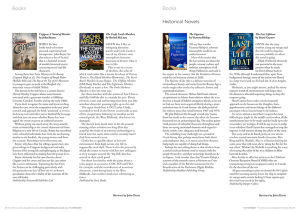
Cultivated Meat
Edited by Michel Vandenbosch and Philip Lymbery
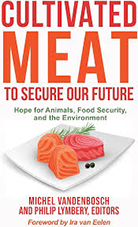
In the eye-opening book Cultivated Meat, the authors delve deep into the harsh realities of the current meat industry, highlighting the alarming truth that “most meat eaten today comes from factory-farmed animals.” This industrial approach to animal rearing has wide-ranging implications: it is cited as “the biggest cause of animal cruelty on the planet, a major driver of wildlife decline, a growing pandemic risk, and is integral to driving climate change.” Through these poignant observations, the book lays bare the pressing need for change.
The book points out that a “sustainable future requires an urgent transformation of the food system to one that is nature-friendly, health-oriented, climate-safe, and sustainable.” This transformation, however, is not without its challenges. The authors acknowledge that there is always concern when new technological developments are presented, however, they say “overcoming these normal facets of technological development shouldn’t be a reason to throw the baby out with the bathwater,” emphasizing the importance of persisting through challenges to achieve meaningful progress.
The book doesn’t shy away from difficult truths either—“the killing of a sentient animal for meat remains an act of violence, no matter how painful or painless the act of taking such a vulnerable individual’s life is.” These realities are often hidden, shielded from consumers who might be unaware suggesting that “if labels on products adorning supermarket shelves were upfront, things would soon be different.” The stark image is painted: “many consumers would recoil in horror knowing their meat comes from disease-ridden factory farms where animals suffer in darkened conditions before an unceremonious end in a slaughterhouse.”
As cultivated meat, described by philosopher Julian Baggini in the book, “becomes viable, it could do more to reduce the number of animals we rear than over a century of animal rights, vegan, and vegetarian campaigning.” The book introduces cultivated meat as a transformative technology that could spark introspection, prompting greater “questioning of what goes on to produce the conventional product.”
The book also provides a disturbing account of current practices: “most of the world’s breeding pigs…experience motherhood in crates, facing the wall, unable to turn round. Cattle are often confined and fed grain instead of grass. Chickens are likely to be caged so they’ll never be able to flap their wings properly or packed so tightly when alive that they will have more room in the oven.” The disappearance of farmed animals from idyllic fields to “cramped, airless hangars and barns” is lamented, with a staggering “some eighty billion farmed animals” produced worldwide each year, two-thirds of them factory-farmed.
Health risks compound the moral and ecological concerns, with “about three-quarters of the world’s antibiotics are fed to farmed animals, largely to ward off diseases inevitable in such unnatural conditions.” The ripple effect extends to the landscape, where this “industrial system” causes fields to expand, leading to the loss of “trees, bushes and hedges…along with wildflowers” essential to ecosystems. The result is a grim chain reaction: as these foundational elements disappear, “the birds, bats, bees, and everything else that depends on them disappears too.”
Reflecting on land use, the book notes that “two-thirds of arable land globally is used to feed factory-farmed pigs, chickens, and cattle.” Yet, “without factory farming, we could feed everyone using less farmland, not more,” promoting a vision of transformation that reconnects “food production, animal welfare, and nature through regenerative, agroecological farming.”
The authors argue that achieving rapid progress requires more than a single solution, however, advocating for a “multiplicity of approaches that go beyond simple ‘sustainability.’” They propose “tomorrow’s sustainable food menu will need a veritable ‘three Rs’ approach—Regenerative farming, Rewilding of the soil, and Reduction of animal-sourced foods.”
In closing, the book issues a cautionary note, recognizing that key figures in the cultivated meat industry have “warned that the first to market bears a responsibility for the perception of the rest.” This insightful and comprehensive examination of our current system and its potential future serves as a clarion call for reform, urging society towards a more compassionate, sustainable way of consuming meat. FB
Published by Lantern Books
Crippen: A Novel of Murder by John Boyne
Review by John Davis
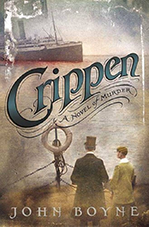
While his later books tend to be more personal, experiential and introspective, John Boyne has also written a lot of ‘faction’ that is a fictional account of notable historical events containing actual real-life characters.
Among them have been Mutiny on the Bounty (Captain Bligh et al), The Congress of Rough Riders (Buffalo Bill) and The Boy at the Top of the Mountain (a youngster goes to work at the Berghof, the mountain retreat of Adolf Hitler).
The person in the title here is a certain Doctor Harvey Hawley Crippen whose name became associated with a gruesome murder at Hilldrop Crescent, Camden, London during the early 1900s.
If you don’t recognise the name and know nothing about the case, resist the temptation to do any ‘prior’ research and approach the book ‘untainted’ as it were. It’s best to wait until after you’ve finished the last page and then you can assess whether Boyne has ‘over-egged’ the events or given an unbiased account.
Without giving too much away, the story actually starts on board ship as the central characters sail from Belgium to a new life in Canada. Boyne has assembled some colourful individuals here from the overbearing mother to the bookish, shy young woman and from the eccentric Frenchman to his obnoxious son.
Boyne, who has a flair for telling a good story, also gives mileage to Crippen’s background and what features of his young life and upbringing in Michigan have been influential in making him the person he is.
Boyne obviously has his own theories about Crippen and his crime and lays out his case rather like a court submission. Separating the fact from the fiction can be challenging particularly with this particular case but ‘all bets are on’ as there is speculation about the validity of the outcome of the case still today.
Published by Transworld Publishers Ltd
The Corfe Castle Murders by Rachel McLean
Review by John Davis
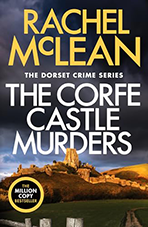
Given that I like an intriguing detection puzzle and Corfe Castle is one of my all-time most atmospheric favourite locations in history, what is not to like.
This is one in a series of thrillers, the titles of which read rather like a tourist brochure of Dorset. There is The Island Murders (Brownsea), The Fossil Beach Murders (Lyme Regis), The Clifftop Murders (Old Harry Rocks) and The Lighthouse Murders (Portland) to name a few. The Poole Harbour Murders is due out next year.
For those familiar with the stories of Ann Cleeves and Elly Griffiths this is certainly for you. Plenty of twists, turns and red herrings that leave you (the armchair detective) guessing right up to the end.
The super sleuth here is DCI Lesley Clarke, seconded to work in the Dorset countryside as part of her recuperation following an incident on her normal patch, the West Midlands, that leaves her damaged.
She doesn’t have much time to hit the ground running either as before too long (first day actually) the body of an eminent archaeologist is found near the castle ruins and he certainly hasn’t died from natural causes.
Clarke has to quickly adjust to her new environment-from high octane city life to supposedly rural idyll. There is also the process by which she comes to terms with her new colleagues as they navigate around the ‘big fish’ that has arrived in their small pond.
For those less familiar with the genre there is some jargon to overcome, CSM, SOI and FLO for example, and the introduction of numerous characters, some dating back to the West Midlands, does tend to need cross referencing at times.
Published by Hera Books
The Figurine by Victoria Hislop
Review by John Davis
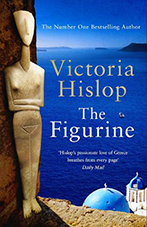
To say that novelist Victoria Hislop is a fervent Graecophile would be an understatement.
Most of the stories that she has written are about the people, scenery, culture and ambient atmosphere of all things Hellenistic and such is her respect in the country that the President of Greece made her an honorary citizen in 2020.
The figurine of the title is a delicate statuette of extraordinary beauty and rarity from the Bronze Age-a much sought after artefact by collectors, looters and unprincipled dealers.
The central character, Helena McCloud, inherits an apartment in Athens from relatives where she is to discover a hoard of hidden antiquities which, as we are to find out later, were acquired illicitly during a more turbulent time in Greek history- the dark period of the military junta that ruled between 1967 and 1974.
We plot Helena’s life through several time frames from her youth to the current day when she becomes fascinated on an archaeological dig. The author paints vivid pictures of colourful characters throughout and there are strong emotional elements with regard to family secrets, love, allegiance and betrayal.
The unfolding story sheds light on a period of Greek history that perhaps many know little about and emphasises that, as in many cases from the past, bad people are capable of doing bad things.
Perhaps the over-riding theme is that artefacts from a nation’s cultural history need to remain with the people themselves and their ownership should not be in dispute. Little wonder then that Victoria Hislop is a patron of the research centre at Knossos on Crete and a member of the British Committee for the Reunification of the Parthenon (Elgin) Marbles.
Published by Headline Publishing Group
The Last Lifeboat by Hazel Gaynor
Review by John Davis
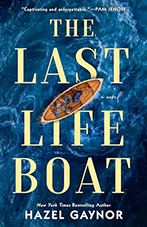
Given that the story involves a long sea voyage and the title itself is a big clue, you can probably see where this novel is going.
Alfred Hitchcock obviously saw potential in the same premise when he made his film Lifeboat back in the 1940s although I understand that, apart from background footage, most of the action was filmed in a large water tank on the back lot of a Los Angeles studio.
Hitchcock, as you might assume, packed his ninety minutes worth of entertainment with larger-than-life characters who did surprising things to keep the suspense going.
Hazel Gaynor has to take a more measured approach so she focuses on the thoughts, fears, apprehensions and inner feelings of the lifeboat’s passengers whose futures hang in the balance.
I’ve never written a novel but I suspect the most difficult part might be the middle section when all the introductions have to be made and the build up to the crescendo is yet to begin. It will be up to you to judge to see whether Hazel Gaynor has managed to keep the impetus in full traction during this phase of the story.
The story, said to be based partly on true events, revolves around two main female characters, Alice King and Lily Nicholls. Alice is a librarian looking for some cause that will mean she is ‘doing her bit for the war effort’. Widow Lily Nicholls is searching for a way of ensuring the safety of her two children in Blitz-battered London.
Alice decides to offer her services to the Children’s Overseas Reception Board (CORB) who are transporting youngsters to apparent safety in Canada for the duration of the war.
All goes according to plan on aboard the SS Carlisle until the escorting convoy leaves the ship to complete its voyage and a certain lurking U-boat captain gets the vessel very much in his sights.
Published by Harper Collins




